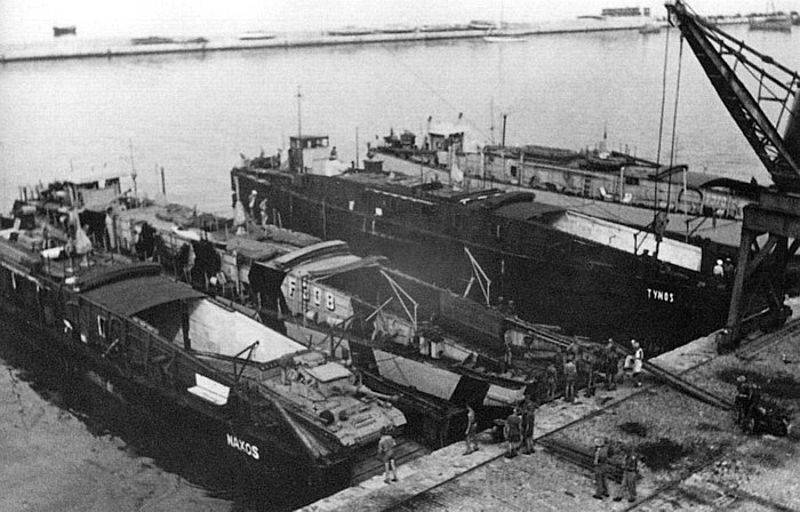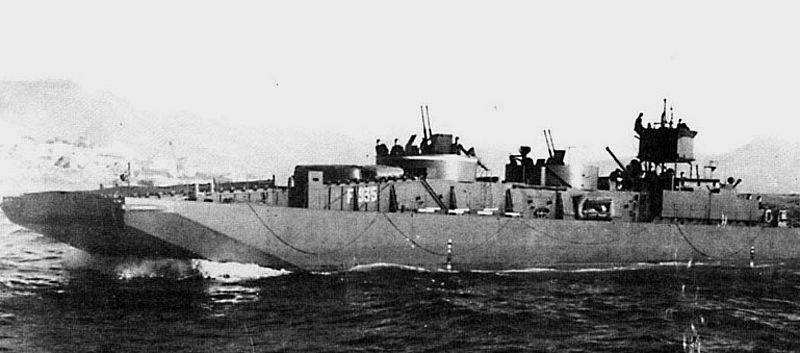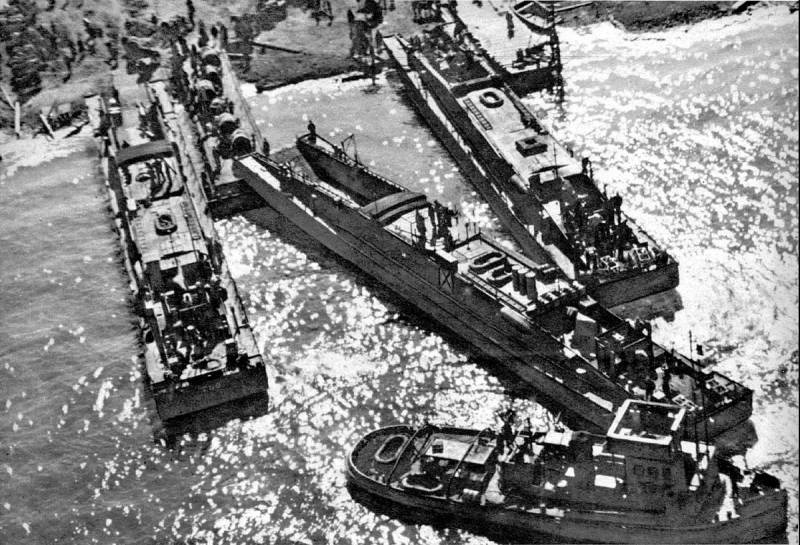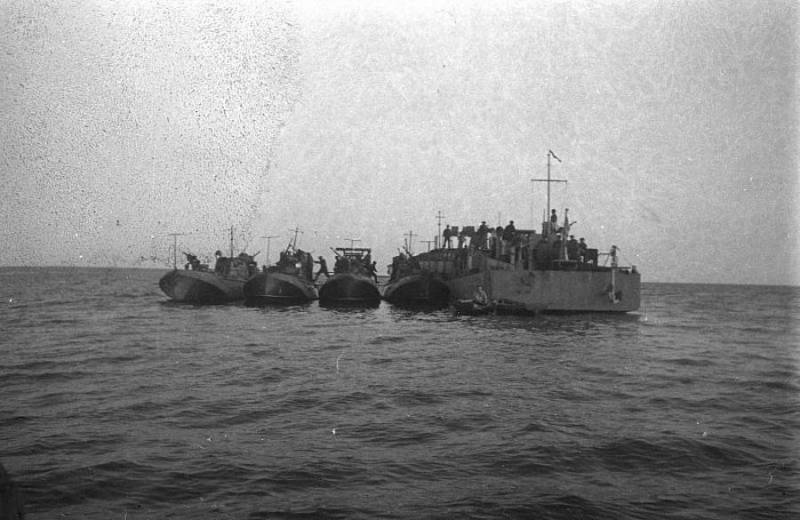Kriegsmarine fast landing barges

High-speed landing barges (BDB) is a definition that has become entrenched and is generally accepted today in the domestic historical literature. At the same time, the German designation for these ships was different - self-propelled sea barges (Marinefährprahm or MFP for short). A series of such warships was used not only in the Kriegsmarine, but also in some fleets Allied states of Nazi Germany in the period from 1941 to 1945.
These landing barges could be called high-speed data with a big stretch, since their speed, according to the declared characteristics, never exceeded 10,5 knots (19,5 km / h). The main tank landing ships of the allies LCT-5 and LCT-6, which developed a speed of 8-10 knots, had approximately the same sailing characteristics. In part, this definition could be explained by good seaworthiness, which made it possible to maintain speed and on the wave, in contrast to smaller landing craft.
The fast landing barges were designed for Operation Sea Lion
Like other German landing ships, the BDB was originally designed for Operation Sea Lion, an invasion of the British Isles. At the same time, Hitler's plans were Napoleonic. Conceiving a landing in Great Britain, he planned to transfer at least 700 thousand soldiers and more than 125 thousand horses across the English Channel, excluding various military equipment.
To cope with this task, the Germans lacked the capabilities of the fleet. In 1940, Germany simply did not have specialized amphibious assault ships of mass construction, and everything that could be hastily commandeered in the ports of the captured European states and withdrawn from the national economy did little to meet the solution of ambitious amphibious tasks.
The infantry could be transferred on various boats, barges, trawlers, lighters and other captured ships, as well as on cruisers and destroyers of the Kriegsmarine. But for transportation tanks, cars and various military equipment, they were not suitable. Civilian ships would have to be extensively redesigned, which was time-consuming. Under these conditions, work began in Germany on the development of specialized amphibious assault vehicles.
Self-propelled sea barges became one of such projects.
They were developed in a fairly short time, the construction was launched already in 1941. But by that time, the vector of Nazi Germany's military policy had finally shifted to the East. By the time the first Type A MFPs were built, Operation Sea Lion had already been canceled.
What were the German BDBs?
The German BDB were easy-to-manufacture and operate ships that could be built in mass quantities even with low-skilled labor. Outwardly, they resembled British and American tank landing ships of the LCT series, as well as Russian amphibious "bolinders" from the period of the First World War.
At the same time, the German landing vehicles had a number of features that distinguished them from the ships of the Allies. So, the second bottom of the German BDB was made flat, which simplified production. Also, all MFPs had a higher double bottom space, which made it possible to abandon the presence of a second side. Reservation of the sides of the landing barges reached 20-25 mm, while the wheelhouse was also reserved on the MFP D series ships, which increased the survivability of the ships.
The BDB bow ramp, the design of which differed from the ramp on the Allied landing ships, seemed to be a completely successful solution. If on the LCT tank landing barges the ramp was simply a lid that folds forward, then on the German BDB the unit consisted of a front gangway and floating structures connected to it by a hinge. This solution provided a gentler and easier descent to the shore of heavy tracked and wheeled vehicles. The total length of the ramp reached 5 meters, which was more than on the Allied ships.
The total length of the BDB hull was 47 meters; the length of the hull of the MFP type D barges increased to almost 50 meters. The maximum draft is 1,45 meters (1,35 meters for the D series). The width of the ships was just over 6,5 meters. The standard displacement is 200-300 tons. The crew of the ships, depending on the options, ranged from 17 to 25 people. The increase in the crew was influenced primarily by the increase in anti-aircraft and artillery weapons on board the barge.
The BDB was driven by three Deutz diesel automobile engines with a total capacity of 390 hp. With. Each of them worked on its own propeller. The maximum speed of the barges was 10,5 knots. At the same time, in the cruising mode, only the middle engine could work, which was enough to provide the BDB with a speed of up to 7,5 knots (approximately 13,5 km / h). When the barges were fully loaded, the speed could be lower. The engines were quite economical; during cruising, the cruising range of the BDB could reach up to 1 nautical miles.
During the war, the German fleet operated high-speed landing barges of four main types.
MFP type B differed in the increased height of the cargo hold (3,19 meters versus 2,74 meters on modification A). This modification could already take on board the Panther and Tiger tanks. At the same time, the carrying capacity of barges of types A, B and C was approximately the same and amounted to 80–100 tons. On the MFP type C modification, the height of the cargo hold was further increased to 3,29 meters.
The largest in the series were the MFP type D barges. The ship's hull was lengthened and slightly widened. The maximum lifting capacity has increased to 140 tons. Instead of an open wheelhouse, a full-fledged armored superstructure appeared on such barges, which, together with the engine compartment, was moved slightly forward. In the superstructure, in addition to the helmsman, there was also a radio room, and on ships of this type there were full-fledged living quarters for the crew.
The armament of the BDB was varied. Anti-aircraft armament, originally represented by only two 20-mm machine guns, was multiplied in the course of hostilities. On those BDBs that were not used in the rear, in 1942, they began to install 75-mm artillery pieces, including captured ones. Over time, 88-mm naval guns began to be installed on the barges.
Encountered modifications
Some of the German MFPs were used as minelayers.
No special alterations of the structure were made for this. At any time, they could be easily returned to the solution of traditional BDB tasks. As a minelayer, the ship took on board up to 36 sea mines of various types. To designate such ships, the letter "M" was added to the name, for example - MFP AM or MFP CM.
The barges were used as minelayers in those theaters of operations where Germany did not have specialized ships or their number was extremely limited. As minelayers, high-speed landing barges were used, in particular, in the Black Sea, as well as in lake and river theaters of operations on the Eastern Front.
The laying of mines with a BDB was most likely the most original in history.
The setting of sea mines was carried out with a lowered ramp, from which the mines were dropped into the water by the crew of the barge. When setting, the ship moved in reverse, which led to a decrease in speed and an increase in the time for setting minefields. This could be critical if surface ships were expected to appear or aviation enemy. Also, this method of laying mines directly depended on the roughness of the sea.
On MFP type DM, mines were set in the usual way - from the stern. On such barges on the upper deck, special rail guides were installed on which mines were placed. In total, such minelayers could carry up to 54 sea mines.
In addition to minelayers, BDBs also existed in the form of artillery ships.
German designation AFP (Artilleriefährprahm - self-propelled artillery barge). The ships had design features: a slightly changed arrangement of living quarters and superstructures, as well as additional booking: from 20 to 100 mm. The superstructures were shifted to the middle of the ship, and the main artillery weapons were placed on the bow and stern on a reinforced deck. The ramp on such ships did not descend, and the ammunition of the guns was stored in the cargo hold.

Changes in the design and installation of artillery systems led to an increase in the mass of the ship by 70-80 tons, while the speed dropped to 8 knots.
Artillery armament, depending on the year of construction or shipyard, could be very different. Basically, it consisted of two 88 mm or two 105 mm guns. In addition, the ships had developed anti-aircraft armament, which could be represented by 1–2 37-mm anti-aircraft guns or two 20-mm quad anti-aircraft guns, plus paired or single 20-mm machine guns.
Combat capabilities of the BDB
During the war years, high-speed landing barges showed their best side.
The Germans actively used these ships in all theaters of operations. In the Baltic, the Black Sea, Norway, the Mediterranean Sea. For example, Italy under license built at least 100 of its barge variants under the designation Motozattera (MZ). There was work everywhere for these ships. In Germany, during the war years, about 700 MFP landing barges of all types were built.
Their main and main task was the transportation and transportation of troops and cargo. But, in addition, MFPs were often used to cover coastal convoys. Due to the presence of advanced weapons on board, such ships were often responsible for providing the air defense of the convoy, and could also drive off small ships and boats of the enemy with artillery fire. Also, the BDB were capable of providing direct fire support to the landing troops or treating coastal targets with fire.
The ships, simple and cheap to manufacture, have proven to be very versatile. Moreover, their small size allowed them to be transported by rail with subsequent assembly on site. This is how the BDB ended up on the Ladoga, Onega and Peipsi lakes, where they were used by German troops.
A significant part of the German fleet in the Black Sea was also made up of BDB and Siebel ferries... At the same time, self-propelled barges, due to the presence of artillery weapons and advanced anti-aircraft weapons, posed a serious threat to all Soviet torpedo boats, small hunters and armored boats.
At the same time, they were a difficult target for aviation. Their small size, good maneuverability and strong anti-aircraft armament, which on some barges was quite comparable to the anti-aircraft armament of a destroyer or destroyer, made them a very dangerous target. It is no coincidence that the Germans often recruited BDB to cover convoys from air strikes.
The small draft of the BDB (1,45 meters in the stern and 1 meter in the bow) was also an important plus, since it often made the barges practically invulnerable to torpedoes of Soviet submarines. At the same time, the design features of the high-speed landing barges made them resistant to light fire, which was predominantly present on board small Soviet surface ships.
The variety of applications has made the high-speed landing barges one of the most versatile ships in the German navy. Conceived as airborne, they often performed combat missions rather than transport missions. For the Kriegsmarine, these were real workhorses, which were often used to plug all the holes that appeared in the absence of other specialized surface ships.




Information